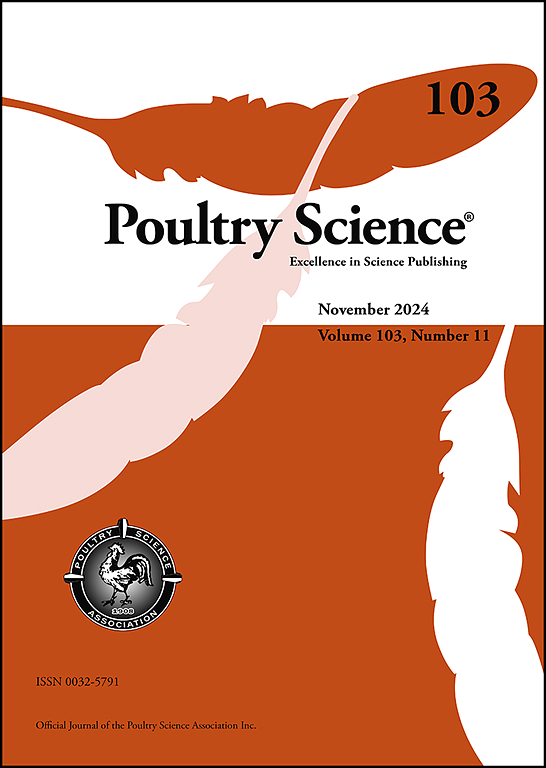Comparative assessment of growth performance and meat quality in Water Hyacinth and antibiotic (growth promoter) supplemented broilers
IF 3.8
1区 农林科学
Q1 AGRICULTURE, DAIRY & ANIMAL SCIENCE
引用次数: 0
Abstract
The use of growth promoters in broiler feed is a common practice to enhance feed efficiency and accelerate growth rates. Ciprofloxacin, a widely used antibiotic in poultry farming, promotes growth and disease prevention but raises concerns about antibiotic residues in meat and the development of antibiotic resistance. This study examines the dietary effects of WH and ciprofloxacin on broiler growth rate, feed conversion ratio (FCR), meat quality, and muscle histology. Ninety broilers were randomly assigned to one of three groups: a control group, a WH-supplemented group (2.5% of daily feed), and a ciprofloxacin (Cipro) group (8 mg/kg body weight). Feed consumption and body weight were monitored daily, and after sacrifice, breast muscles were collected for meat quality assessment and histopathological analysis. WH supplementation significantly improved (P < 0.05) body weight gain, feed conversion ratio (FCR), and meat quality in broilers. Compared to control and ciprofloxacin groups, WH-treated broilers exhibited lower cooking and drip loss (P < 0.05), higher water-holding capacity (P < 0.01), and reduced shear force value (P < 0.05), indicating improved texture. Ciprofloxacin treatment resulted in reduced redness (P < 0.001) and increased yellowness (P < 0.01), while lightness remained unchanged across groups. Histological analysis revealed greater perimysium thickness and intermuscular adipose infiltration in WH-treated broilers, suggesting enhanced muscle structure. WH supplementation presents a safer, sustainable alternative to antibiotics in broiler production.
添加水葫芦和抗生素(生长促进剂)对肉鸡生长性能和肉品质的比较评价
在肉鸡饲料中使用生长促进剂是提高饲料效率和加快生长速度的一种普遍做法。环丙沙星是一种在家禽养殖中广泛使用的抗生素,它能促进生长和预防疾病,但也引起了人们对肉类中抗生素残留和抗生素耐药性发展的担忧。本试验旨在研究饲粮中添加WH和环丙沙星对肉鸡生长速度、饲料系数、肉品质和肌肉组织的影响。将90只肉仔鸡随机分为3组:对照组、whh添加组(日饲料的2.5%)和环丙沙星(Cipro)组(8 mg/kg体重)。每天监测饲料消耗和体重,屠宰后采集胸肌进行肉质评价和组织病理学分析。补充肝素显著改善(P <;0.05)增重、饲料系数(FCR)和肉品质。与对照组和环丙沙星组相比,经wh处理的肉鸡蒸煮和滴漏损失较低(P <;0.05),较高的持水量(P <;0.01),减小剪切力值(P <;0.05),质地得到改善。环丙沙星治疗可减少红肿(P <;0.001),黄度增加(P <;0.01),而各组间亮度保持不变。组织学分析显示,经whd处理的肉鸡肌膜厚度和肌间脂肪浸润增加,表明肌肉结构增强。在肉鸡生产中,补充WH是一种更安全、可持续的抗生素替代品。
本文章由计算机程序翻译,如有差异,请以英文原文为准。
求助全文
约1分钟内获得全文
求助全文
来源期刊

Poultry Science
农林科学-奶制品与动物科学
CiteScore
7.60
自引率
15.90%
发文量
0
审稿时长
94 days
期刊介绍:
First self-published in 1921, Poultry Science is an internationally renowned monthly journal, known as the authoritative source for a broad range of poultry information and high-caliber research. The journal plays a pivotal role in the dissemination of preeminent poultry-related knowledge across all disciplines. As of January 2020, Poultry Science will become an Open Access journal with no subscription charges, meaning authors who publish here can make their research immediately, permanently, and freely accessible worldwide while retaining copyright to their work. Papers submitted for publication after October 1, 2019 will be published as Open Access papers.
An international journal, Poultry Science publishes original papers, research notes, symposium papers, and reviews of basic science as applied to poultry. This authoritative source of poultry information is consistently ranked by ISI Impact Factor as one of the top 10 agriculture, dairy and animal science journals to deliver high-caliber research. Currently it is the highest-ranked (by Impact Factor and Eigenfactor) journal dedicated to publishing poultry research. Subject areas include breeding, genetics, education, production, management, environment, health, behavior, welfare, immunology, molecular biology, metabolism, nutrition, physiology, reproduction, processing, and products.
 求助内容:
求助内容: 应助结果提醒方式:
应助结果提醒方式:


